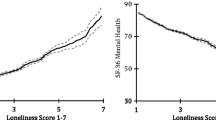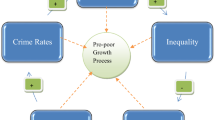Abstract
This article illustrates the difference between individual and structural accounts of poverty in the U.S. Some of the correlates of poverty among individuals are job loss, low skills, female family head, discrimination against blacks and hispanics, family size, and age at marriage. The structural factors producing a high rate of poverty are the reproduction of the class system, macroeconomic policies, the vicious circle of poverty, the structure of the electoral process, the structure of the economy, institutionalized gender discrimination, and institutionalized ethnic discrimination. Thus, the variables accounting for each phenomenon are different. A theoretical rationale for the relationship between social structure and rates of events is presented, and similarities between the approach used here and research in other disciplines are noted.
Similar content being viewed by others
References
Bakke, E.W. (1940).The Unemployed Worker. New Haven, Ct.: Yale University Press.
Beck, E.M., P.M. Horan, and C.M. Tolbert (1978) ‘Stratification in a Dual Economy’,American Sociological Review 43: 704–20.
Becker, G.S. (1975).Human Capital. 2nd Edition, New York: Columbia University.
Beeghley, L. (1983).Living Poorly in America. New York: Preager.
Beeghley, L. (1984). ‘Illusion and Reality in the Measurement of Poverty’,Social Problems 31: 312–24.
Beeghley, L. (1986). ‘Social Class and Political Participation: A Review and an Explanation’,Sociological Forum 1: 496–514.
Beeghley, L. and C. Sellers (1986). ‘Adolescents and Sex: A Structural Theory of Premarital Sex in the United States’,Deviant Behavior 7: 313–36.
Beeghley, L., E. Van Elsor, and E.W. Bock (1981). ‘The Correlates of Religiosity among Black and White Americans”,Sociological Quarterly 22: 403–12.
Benokraitis, N., and J.R. Feagin (1986)Modern Sexism: Blatant, Subtle, and Covert Discrimination. Englewood Cliffs, NJ: Prentice-Hall.
Bibb, R., and W. Form (1977). ‘The Effects of Industrial, Occupational, and Sex Stratification on Wages in Blue Collar Markets’,Social Forces 55: 974–96.
Blake, J., and K. Davis (1964). ‘Norms, Values, and Sanctions’, in R.E.L. Faris (ed.),Handbook of Modern Sociology. Chicago: Rand McNally.
Blau, P.M. (1975).Approaches to the Study of Social Structure. New York: Free Press.
Blau, P.M., T.C. Blum, and J.E. Schwartz (1982). ‘Heterogeneity and Intermarriage’,American Sociological Review 47: 45–67.
Blau, P.M., and O.D. Duncan (1967).The American Occupational Structure. New York: Wiley.
Blau, P.M., and R.K. Merton (1981).Continuities in Structural Inquiry. Beverley Hills, CA: Sage.
Boyd, R.W. (1981). ‘Decline in U.S. Voter Turnout: Structural Explanations’,American Politics Quarterly 9: 133–159.
Bowlby, J. (1953).Child Care and the Growth of Love. Baltimore MD: Penguin.
Bryant, C.G.A. (1985),Positivism in Social Theory and Research. New York: St. Martin's Press.
Burnham, W.D. (1980) ‘The Appearance and Disappearance of the American Voter’, in R. Rose (ed.),Electoral Participation. Beverly Hills, CA: Sage.
Corcoran, M., L. Datcher, and G.J. Duncan (1980). ‘Most Workers Find Jobs Through Word of Mouth’,Monthly Labor Review 103 (August): 33–36.
Duncan, G.J. (1984).Years of Poverty, Years of Plenty. Ann Arbor, MI: Institute for Social Research, University of Michigan.
Durkheim, E. (1895).Rules of the Sociological Method. New York: Free Press, 1982.
Durkheim, E. (1897).Suicide. New York: Free Press, 1935.
Farley, R. (1984).Blacks and Whites: Narrowing the Gap? Cambridge, MA: Harvard University Press.
Feagin, J.R., and C.B. Feagin (1978).Discrimination American Style. Englewood Cliffs. NJ: Prentice-Hall.
Featherman, D.L., and R.M. Hauser (1978).Opportunity and Change. New York: Academic Press.
Gans, H. (1972). ‘The Positive Functions of Poverty’,American Journal of Sociology 78: 275–89.
Ginsberg, H. (1983).Full Employment and Public Policy: The United States and Sweden. Boston: Lexington Books.
Gordon, D.M. (1972).Theories of Poverty and Unemployment. Lexington, MA: D. C. Heath.
Hayghe, H. (1986). ‘Rise in Mother's Labor Force Activity Includes those with Infants’,Monthly Labor Review 109(February): 43–45.
Heilbronner, R., and L. Thurow (1982).Economics Explained. Englewood Cliffs, NJ: Prentice-Hall.
Hibbs, D.A. (1977). ‘Political Parties and Macroeconomic Policy’,American Political Science Review 71: 1467–87.
Hicks, A., and D.H. Swank (1983). ‘Civil Disorder, Relief Mobilization, and AFDC Caseloads: A Reexamination of the Piven and Cloward Thesis’,American Journal of Sociology 27: 695–716.
Hodgson, R., and R.L. Kaufman (1982). ‘Economic Dualism: A Critical Review’,American Sociological Review 47: 727–39.
Jensen, R. (1971).The Winning of the Midwest. Chicago: University of Chicago Press.
Jewell, M.E., and D.M. Olson (1978).American State Political Parties and Elections. Homewood, IL: Dorsey Press.
Jones, E.F., et al. (1985). ‘Teenage Pregnancy in Developed Countries: Determinants and Policy Implications’,Family Planning Perspectives 17: 53–63.
Karnig, A.D., and B.O. Walter (1977). ‘Municipal Elections: Registration, Incumbent Success, and Voter Participation’, inMunicipal Yearbook. Washington, DC: International City Management Association.
Lenski, G. (1967).Power and Privilege. New York: McGraw-Hill.
Lewis, O. (1969). ‘The Culture of Poverty’, in D.P. Moynihan (ed.),On Understanding Poverty, New York: McGraw-Hill.
Liker, J.K., and G.H. Elder, Jr. (1983). ‘Economic Hardship and Marital Relations in the 1930s’,American Sociological Review 48:343–359.
Merton, R.K. (1968).Social Theory and Social Structure. New York: Free Press.
Mellor, E.F. (1987). ‘Workers at the Minimum Wage or Less: Who They are and the Jobs They Hold’,Monthly Labor Review 110(July): 34–38.
Moore, J., and H. Pachon (1985).Hispanics in the United States. Englewood cliffs, NJ: Prentice-Hall.
Olsen, M.E. (1982).Participatory Pluralism. Chicago: Nelson-Hall.
Parsons, T. (1954). ‘The Kinship System in the United States,’ in T. Parsons,Essays in Sociological Theory. Revised edition. New York: Free Press.
Patterson, J.T. (1986).America's Struggle Against Poverty, 1900–1985. Cambridge, MA: Harvard University Press.
Pearlin, L.I., E.G. Menaghan, M.A. Lieberman, and J.T. Mullin (1981). ‘The Stress Process’,Journal of Health and Social Behavior 22: 337–356.
Piven, F. Fox, and R. Cloward (1971).Regulating the Poor. New York: Vintage Books.
Powell, G.B. (1980). ‘Voter Turnout in Thirty Democracies: Partisan, Legal, and Socioeconomic Differences’, in R. Rose (ed.),Eelectoral Participation. Beverley Hills, CA: Sage.
Rubin, L. (1976)Worlds of Pain. New York: Basic Books.
Sagan, C. (1984). ‘Nuclear War and Climatic Catastrophe’,Foreign Affairs 62: 257–292.
Snipp, C.M. (1985). ‘Occupational Mobility and Social Class: Insights from Men's Career Mobility,’.American Sociological Review 50: 475–492.
Stinchcombe, A. (1975). ‘Merton's Theory of Social Structure’, in L.S. Coser (ed.),The Idea of Social Structure. New York: Free Press.
Thompson, S.L. and S.H. Schneider (1986). ‘Nuclear Winter Reappraised’,Foreign Affairs 64: 981–1005.
Turner, F.J. (1920).The Significance of the Frontier in American History. New York: Henry Holt.
Turner, J.H. (1972).Patterns of Social Organization. New York: McGraw-Hill.
Turner, J. H. (1986). ‘Toward a Unified Theory of Ethnic Antagonism’,Sociological Forum 1: 403–427.
Turner, J.H. (1986a).The Structure of Sociological Theory. Fourth Edition: Chicago: Dorsey Press.
Turner, J.H., and L. Beeghley (1981).The Emergence of Sociological Theory. Homewood, IL: Dorsey Press.
United States Bureau of Labor Statistics (1986).Employment and Earnings. Washington, DC: U.S. Government Printing Office.
United States Census Bureau (1985). ‘Money Income and Poverty Status of Families and Persons in the United States, 1984’,Current Population Reports, Series P-60, No. 149, Washington, DC: U.S. Government Printing Office.
United States Census Bureau (1985a). ‘Characteristics of Households Receiving Selected Noncash benefits: 1984’, Current Population Report, Series P-60, No. 150. Washington, DC: U.S. Government Printing Office.
United States Census Bureau (1987). ‘Money Income and Poverty Status of Families and Persons in the United States, 1986’,Current Population Reports, Series P-60, No. 157. Washington, DC: U.S. Government Printing Office.
United States Department of Labor (1985).Monthly Labor Review 108(October):85–95.
United States Department of Labor (1985a).Monthly Labor Review 108(December):61.
Valentine, B. (1978)Hustling and Other Hard Work. New York: Free Press.
Verba, S., and N.H. Nie (1972).Participation in America. New York: Harper & Row.
Weber, M. (1905).The Protestant Ethic and the Spirit of Capitalism. New York: Scribners, 1958.
Weber, M. (1920).Economy and Society. New York: Bedminster Press, 1968.
Weber, M. (1921).General Economic History. New York: Collier Books, 1961.
Weitzman, Lenore (1985)The Divorce Revolution. New York: Free Press.
Willer, D., and M. Webster (1970). ‘Theoretical Concepts and Observables’,American Sociological Review 35: 748–756.
Williams, R.M. (1970).American Society. Third edition. New York: Knopf.
Wolfinger, R.E., and S.J. Rosenstone (1980).Who Votes? New Haven, CT: Yale University Press.
Zelizer, V.A. (1985).Pricing the Priceless Child. New York: Basic.
Author information
Authors and Affiliations
Rights and permissions
About this article
Cite this article
Beeghley, L. Individual and structural explanations of poverty. Popul Res Policy Rev 7, 201–222 (1988). https://doi.org/10.1007/BF02456102
Issue Date:
DOI: https://doi.org/10.1007/BF02456102




